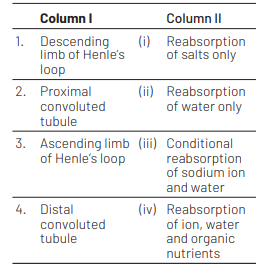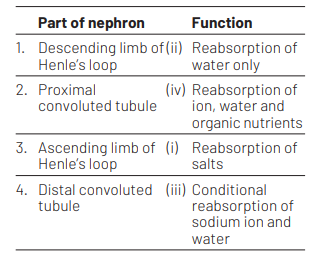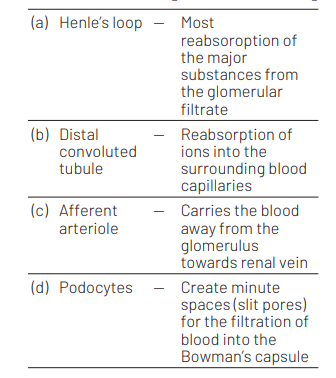Question
The increase in osmolarity from outer to inner medullary interstitium is maintained due to [NEET (Oct.) 2020]
I. close proximity between Henle’s loop and vasa recta
II. counter-current mechanism
III. selective secretion of $\mathrm{HCO}_3^{-}$and hydrogen ions in $\mathrm{PCT}$.
IV. higher blood pressure in glomerular capillaries
(a) Only II
(b) III and IV
(c) I, II and III
(d) I and II
Answer/Explanation
Ans. (d)
Statements in option (d) are correct as the close proximity between the Henle’s loop and vasa recta as well as the counter-current in them help in maintaining an increasing osmolarity towards the inner medullary interstitium, i.e. from $300 \mathrm{mOsmol} \mathrm{L}{ }^{-1}$ in the cortex (outside) to about $1200 \mathrm{mOsmol} \mathrm{L}^{-1}$ in the inner medulla (inside).
Question
Match the following parts of a nephron with their function. [NEET (Odisha) 2019

Select the correct option from the following.
1 2 3 4
(a) (i) (iii) (ii) (iv)
(b) (ii) (iv) (i) (iii)
(c) (i) (iv) (ii) (iii)
(d) (iv) (i) (iii) (ii)
Answer/Explanation
Ans. (b)
The correct matches are

Question
Which of the following statements is correct? [NEET 2017]
(a) The ascending limb of loop of Henle is impermeable to water
(b) The descending limb of loop of Henle is impermeable to water
(c) The ascending limb of loop of Henle is permeable to water
(d) The descending limb of loop of Henle is permeable to electrolytes
Answer/Explanation
Ans. (a)
The ascending limb of loop of Henle is impermeable to water and permeable to $\mathrm{K}^{+}, \mathrm{Cl}^{-}$and $\mathrm{Na}^{+}$and partially permeable to urea. Due to this, sodium, potassium, calcium, magnesium and chloride are reabsorbed here making the filterate hypotonic.
Question
The part of nephron involved in active reabsorption of sodium is [NEET 2016, Phase II]
(a) distal convoluted tubule
(b) proximal convoluted tubule
(c) Bowman’s capsule
(d) descending limb of Henle’s loop
Answer/Explanation
Ans. (b)
Proximal convoluted tubule is involved in active reabsorption of sodium. The majority (about 70\%) of sodium is reabsorbed here, into the cytosol of the epithelial cells of the nephron.
Question
Which of the following causes an increase in sodium reabsorption in the distal convoluted tubule? [CBSE AIPMT 2014]
(a) Increase in aldosterone levels
(b) Increase in antidiuretic hormone levels
(c) Decrease in aldosterone levels
(d) Decrease in antidiuretic hormone levels
Answer/Explanation
Ans. (a)
Increase in aldosterone levels cause an increase in sodium reabsorption in DCT. It is secreted by outer layer of adrenal gland when aldosterone is present in the blood and all the $\mathrm{Na}$ ions in the filterate are reabsorbed. Retaining $\mathrm{Na}^{+}$raises the osmotic pressure of the blood and reduces the water loss from the body.
Question
The maximum amount of electrolytes and water (70-80\%) from the glomerular filtrate is reabsorbed in which part of the nephron? [CBSE AIPMT 2012]
(a) Ascending limb of loop of Henle
(b) Distal convoluted tubule
(c) Proximal convoluted tubule
(d) Descending limb of loop of Henle
Answer/Explanation
Ans. (c)
From the Bowman’s capsule, the glomerular filtrate enters the proximal convoluted tubule (PCT). PCT is surrounded by a network of peritubular capillaries and is the seat of reabsorption. About $75 \%$ of glomerular filtrate is normally reabsorbed in PCT before reaching the loop of Henle. The reabsorbed materials include glucose, amino acids, vitamins, hormones, sodium, potassium, chlorides, phosphates, bicarbonates, most of the water and some urea, etc.
Question
Which one of the following correctly explains the function of a specific part of a human nephron? [CBSE AIPMT 2011]

Answer/Explanation
Ans. (d)
Podocytes or visceral epithelial cells are the cells in Bowman’s capsule in the kidneys that wrap around the capillaries of glomeruls. They create minute pores (slit pores) for the filtration of blood into the Bowman’s capsule.
Question
Injury to adrenal cortex is not likely to affect the secretion of which one of the following? [CBSE AIPMT 2010]
(a) Aldosterone
(b) Both androstenedione and dehydroepi- androsterone
(c) Adrenalin
(d) Cortisol
Answer/Explanation
Ans. (c)
The adrenal medulla synthesises two hormones adrenaline (epinephrine) and non-adrenaline (non-epinephrine). These hormones are proteinaceous in nature and derived from amino acid tyrosine. Thus, injury to adrenal cortex will not affect the secretion of adrenaline.
Question
Which one the following statements in regard to the excretion by the human kidneys is correct? [CBSE AIPMT 2010]
(a) Descending limb of Loop of Henle is impermeable to water
(b) Distal convoluted tubule is incapable of reabsorbing $\mathrm{HCO}_3$
(c) Nearly $99 \%$ of the glomerular filtrate is reabsorbed by the renal tubules
(d) Ascending limb of loop of Henle is impermeable to electrolytes
Answer/Explanation
Ans. (c)
The plasma fluid that filters out from glomerular capillaries into Bowman’s capsule of nephron is called glomerular filtrate. A comparison of the volume of the filtrate formed per day ( $180 \mathrm{~L} /$ day) with that of the urine released $(1.5 \mathrm{~L})$, suggests that nearly $99 \%$ of the filtrate has to be reabsorbed by the renal tubules in a process called reabsorption.
Question
The net pressure gradient that causes the fluid to filter out of the glomeruli into the capsule is [CBSE AIPMT 2005]
(a) $20 \mathrm{mmHg}$
(b) $75 \mathrm{mmHg}$
(c) $30 \mathrm{mmHg}$
(d) $50 \mathrm{mmHg}$
Answer/Explanation
Ans. (a)
Kidneys help in the formation of urine, from the blood flowing through glomerular capillaries. About $20 \%$ of plasma fluid filters out into the Bowman’s capsule through a thin glomerular-capsular membrane due to a net or effective filtration of about 10-15 mm Hg. So, it is the nearest option (a) which is correct.
Question
If Henle’s loop were absent from mammalian nephron, which of the following is to be expected? [CBSE AIPMT 2003]
(a) The urine will be more concentrated
(b) The urine will be more dilute
(c) There will be no urine formation
(d) There will be hardly any change in the quality and quantity of urine formed
Answer/Explanation
Ans. (b)
The main function of the Henle’s loop is to absorb water from the tubular lumen, thus making the urine concentrated. If loop of Henle absent then the urine becomes more dilute.
Question
The ability of the vertebrates to produce concentrated (hyperosmotic) urine usually depends upon the [CBSE AIPMT 2000]
(a)area of Bowman’s capsule epithelium
(b) length of Henle’s loop
(c) length of the proximal convoluted tubule
(d) capillary network forming glomerulus
Answer/Explanation
Ans. (b)
Length of Henle’s loop determined the concentration of urine. Urine is concentrated through counter current mechanism which involves (a) the loop of Henle (b) the vasa recta (c) nearby collecting tubules and ducts $\mathrm{s}_{\mathrm{r}}$ (d) the interstitial fluid.
Question
Under normal conditions which one is completely reabsorbed in the renal tubule? [CBSE AIPMT 1991]
(a) Urea
(b) Uric acid
(c) Salts
(d) Glucose
Answer/Explanation
Ans. (d)
Glucose is high threshold substance, i.e., it is totally or mostly reabsorbed from the nephric filtrate in the blood capillaries.Renal threshold, i.e., upper limit of kidney to reabsorb such high threshold substances of kidney for reabsorption of glucose is about $180 \mathrm{mg} / 100 \mathrm{~mL}$ of nephric filtrate. When blood sugar level reaches beyond this, sugar also appears in urine.
Question
The basic functional unit of human kidney is [CBSE AIPMT 1997]
(a) nephron
(b) pyramid
(c) nephridia
(d) Henle’s loop
Answer/Explanation
Ans. (a)
Each human kidney consists of about one million structural and functional units called nephrons. Each nephron is mainly made up of two parts :
(i) Malpighian body
(ii) Renal tubule.
Nephridia are excretory tubules found in the Platyhelminthes (flatworms) and annelids (earthworms).
Question
Reabsorption of useful substances from glomerular filtrate occurs in [CBSE AIPMT 1989]
(a) collecting tube
(b) loop of Henle
(c) proximal convoluted tubule
(d) distal convoluted tubule
Answer/Explanation
Ans. (c)
Proximal convoluted tubule is the main site for the reabsorption of useful substances from glomerular filtrate. In PCT complete reabsorption by active transport takes place for glucose.
PCT reabsorbs most of the amino acids and vitamin- $-$, about $70 \%$ of $\mathrm{Na}^{+}$and nearly $75 \%$ of $\mathrm{K}^{+}$and a large amount of $\mathrm{Ca}^{2+}$ from glomerular filtrate.
$\mathrm{Cl}^{-}$is reabsorbed by diffusion. $70 \%$ of water from filtrate is also reabsorbed in PCT by osmosis.
